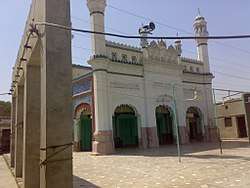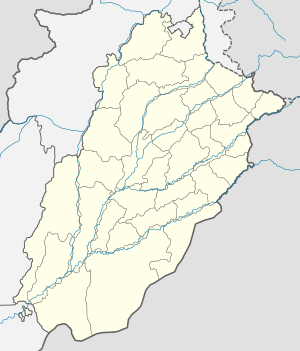Khanewal
Khanewal (Punjabi and Urdu: خانیوال) is a city and the capital of Khanewal District in the Punjab province of Pakistan.[3] It is the 36th largest city of Pakistan by population. Khanewal is named after the earliest settlers here who belonged to the caste ‘Daha’ (A Sub-Caste of Panwar Rajput) and used ‘Khan’ in their names. That is how the city came to be known as ‘khan-e-wal’.
Khanewal خانیوال | |
|---|---|
 | |
 Khanewal  Khanewal | |
| Coordinates: 30°18′N 71°56′E | |
| Country | |
| Province | |
| Division | Multan |
| District | Khanewal |
| Government | |
| • Deputy Commissioner | Agha Zaheer Abbas Sherazi |
| Elevation | 128 m (420 ft) |
| Population | |
| • City | 227,059 |
| • Rank | 36th, Pakistan |
| Time zone | UTC+5 (PST) |
| Number of towns | 1 |
| Number of Union councils | 6 |
| [2] | |
History

Khanewal has a rich and vibrant history which can be traced back to the early 1900s. Khanewal is famous for its cotton growing industry. Dahas are regarded as the initial settlers and founders of Khanewal. Khagga, Haraj, Daha, Bodla, Siyal are the largest castes of Khanewal. Historically Khanewal is an old city having its earliest foundations laid by the British Empire owing to its importance as a railway junction. The city was a junction of the Wazirabad-Khanewal railway line and provided a connection to the city of Karachi via Lahore. Its straight roads show that it is a well planned town by the British people. The land where Khanewal is currently situated was barren originally and was called Gunji Bar or Kabirwala Bar. Bar is a geographical term used to describe elevated land on sides of rivers. Initially this area used to be Southern shore of river Ravi. At that time Ravi used to flow from East to West of Multan city. With the passage of time, the river kept changing its flow, the river soil turned this piece of land into a vegetated land. With ample trees in the area, a tribe called the Khan Daha tribe moved to this place in 1700s. This area was populated by Khan Zayadat Khan Daha, the forefather of Daha family. It is said that he was originally from Darwar State Central India but then migrated to Bahawalpur. After trying his luck in Bahawalpur, he moved to Pak-Pattan. Then in 1820s, he moved to this region after getting employment under Dewan Sawan Mall. As an employee, he was made responsible for collection and payments from Tulamba, Tiba Sultan Pur, Kot Kamalia and Luddan. He got famous in the region as Khan and thus this area was named Khan-e-wala. Singhar Khan Daha was the 34th descendant of Tikkey Khan Daha, the first Muslim in Daha family and accepted Islam on the hands of Hazrat Bahauddin Zakariya (R.A). Singhar Khan Daha is said to have moved to Khanewal from Pak-Pattan in 1700. It is said that he built a castle in the area. The family lived here for long and Hassan Khan Daha, 37th descendent of Tikkey Khan Daha, became one of the most prominent businessmen of the region. Hassan Khan Daha was awarded Sanad from Pathan Governments in 1768. Till now Dahas are the rulers of Khanewal and till now are a part of Local, Provincial and National Governments. In 1700 Daha Tribe moved to Khanewal 1860 Railway Station was built in Khanewal In 1901 Khanewal was still part of Kabirwala Tehsil and its name was Khan-e-walah. 1903 Shah Muhammad Khan Daha (a famous politician of that era) awarded Sanad by British Government for his works in Khanewal 1906 Digging for Lower Bari Doab Canal started and Sir William Roberts (owner of RCA) was Principal of Bombay College at that time 1908 Lower Bari Doab Office and Quarter built 1911 Khanewal given status of a City; Shah Muhammad Khan Daha again awarded Sanad; First extension of Canal Office started 1912 Khanewal started developing; Allotment of plots in Khanewal started; First hospital of Khanewal (Railway hospital) built; First officer of Canal Office assigned to Khanewal; William Roberts of RCA became principal of Agriculture College of Faisalabad 1913 Lower Bari Doab Canal completed and inaugurated 1916 Khanewal was awarded the status of Tehsil 1923 British Cotton and Ginning Association Factory (BCGA) started operations and Khan Haibat Khan Daha elected as a member of Punjab Legislative Council 1924 Railway South Cabin opened in Khanewal; Extra Assistant Commissioner Court opened in Khanewal; SCO Canal Office Court opened 1926 Municipal Library built in Khanewal; First bank of Khanewal (Central Co-operative Bank) opened in Khanewal; Chaman Lal Cotton Factory built 1928 First Electric House (Bijli ghar) built in Khanewal by Railway; 149 Pole lamps installed in Khanewal; Civil Veterinary Hospital built 1934 Khan Haibat Khan Daha and Sir William Roberts became member of Punjab Provincial Assembly Historically Khanewal is a relatively modern city having its earliest foundations laid by the British Empire owing to its importance as a railway junction. The city was a junction of the Khanewal–Wazirabad railway line and provided a connection to the city of Karachi via Lahore.[4][5]
College and schools
- Khanewal Public School and College, Khanewal
- Superior Group of Colleges Khanewal
- Punjab Group of Colleges Khanewal
- Punjab College of Business Administration Peoples Colony
- The City School Senior and Junior branch
Notable people
- Syed Fakhar Imam, Ex. Speaker National Assembly of Pakistan
- Iftikhar Anjum, Pakistani cricketer
- Nishat Khan Daha, (Member Punjab Provincial Assembly)
- Muhammad Khan Daha, (Member National Assembly of Pakistan)
References
- "PAKISTAN: Provinces and Major Cities". PAKISTAN: Provinces and Major Cities. citypopulation.de. Retrieved 4 May 2020.
- Location of Khanewal – Falling Rain Genomics
- Tehsils & Unions in the District of Khanewal – Government of Pakistan Archived 2011-08-07 at the Wayback Machine
- Glossary Of The Tribes And Castes Of The Punjab And North-west Frontier ... By H.A. Rose Page 219
- Punjab – Imperial Gazetteer of India, v. 20, p. 324.